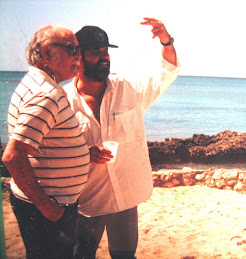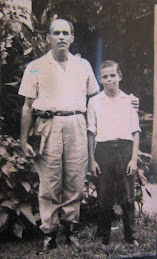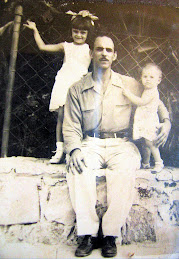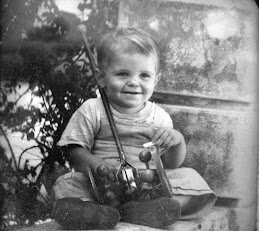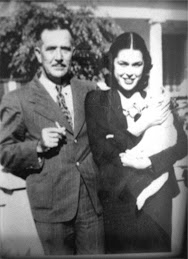
This is a chapter of a book of short stories still in the works --
Black and White In Havana : The Case of Pedro the Chauffeur
When I was about 11, one of our neighbors had a ‘chauffeur’ called Pedro ---whom I now realize was a splendid light-skinned black man.
Young, tall, rippling muscles and a medium brown skintone, he was -- no matter how handsome or sexy--- a black man in Havana in the 50’s, and that could mean many things.
A mulatto -or a light shaded black man or woman, whatever you preferred to call it- with thick lips and wiry hair, faced special circumstances. Depending on whom you talk to, this could very significant, or totally inconsequential.
Compared with the American South at the times --with its "Colored" bathrooms and ride-in-the-back-of-the-bus laws-- in Cuba there was only a very ’mild’ form of racism. But there certainly was ’a difference’ between whites and blacks. A difference that was more ’social’ and 'economical' than anything else.
“Poor whites” and “poor blacks” were all thrown together in the same pot and lived side by side in harmony in tenements, public schools, hospitals and public transportation. Talented black performers were revered and achieved fame and fortune--but don’t try to invite them to dinner at your private club because you could cause quite an uproar!
On the othe hand, poor blacks and wealthy (or almost-wealthy) Cubans lived in well defined -and very different levels , although these were not hostile, nor confrontational levels, but more subtler ones. It was more of a well understood and discreet 'rank of places and things’ ---than a 100% open and blatant racism. Things had been like that since the colonial times, when blacks slaves had been brought to Cuba from Africa. They had started improving when -on the 10th of October of 1868- wealthy Cuban white patriot Carlos Manuel de Céspedes launched the beginning of the long War of Independence from Spain and freed all his slaves; and ever since - sadly- they had not advanced very much.
While white Cubans had their social clubs, where blacks did not even dare to apply for membership, black Cubans also had theirs, with exactly the same restrictions!
Curiously, deep-rooted and fierce racism was more common among white families that were ‘hiding’ some black genes in their blood. ('¿Y tu abuela dónde está?') . Or among those who were mean of spirit , or very insecure social climbers. An example of Cuba's curious racism was President Fulgencio Batista himself, a handsome dark skinned mulatto who was ’the’ President and Commander in Chief of Cuba’s Armed Forces, but still unable to -ever!- become a member of the very exclusive Havana Yacht Club.
I remember Pedro the chauffeur so vividly because his life would eventually become intertwined with ours-- and because of the scandal that happened when this young white girl who worked as a maid near our house, lost her virginity to Pedro!
In Cuba virginity was ’the’ most important requisite for marriage among ’good girls’. A sign of moral fortitude and high values. The Seal of Approval! Girls were always very worried about losing their virginity; since it was rumored that “even riding a horse” could break the ‘hymen’ --and bring immediate shame to a whole family!
I clearly remember listening to the very hush-hush stories and the fact that after her ‘liasion’ with Pedro "el negro", her own dirt-poor parents had thrown her out of the house. Every time I saw the girl around the neighborhood the thought of her ‘tragedy’ came to my mind and I immediately would feel very sorry for her. One one ocassion I saw her walking with Pedro. He had his arms around her waist and they looked very happy together. This really stunned me! It was the first time I saw an interracial couple --something very unusual in Cuba in the 50’s-- and it was quite a shock. I did not know if I should had felt disgusted or simply aghast. It was an incident that troubled me even more because our black cook was also “repelled” by the sight --and made a snide comment about “the unsuitability of the situation, since blacks should stick with blacks and whites with whites”.
Ever since, I have felt both bewilderement and a silent admiration for women who dare to go out and fall in love with men of other races. In Cuba it was such a 'taboo' thing! Something that brought immediate shame and rarely happened among middle class, or wealthy families -- but was ocassionally seen among the more humble and the poor. Also among many men from Spain, who loved having a beautiful ‘mulatto’ mistress behind their wives backs!
After the big ‘scandal’ the whole neighborhood was rocked, since the young girl and Pedro openly became lovers and met almost every afternoon in the room he had in the house where he worked. I remember the comings and goings of all the servants and the incessant whispering. We children were not supposed to hear those things and even my very naive mother was spared the ‘ugly gossip’ --but nonetheless it was a fascinating story. Apparently the young girl did not love Pedro, but "she simply could not get enough of him". Like a Tropical Belle de Jour, she had discovered an impudent side to her, and --according to our cook, who telephoned her sister every afternoon to update her with the latest events-- “she kissed Pedro’s feet and hands and licked his body and his toes and fingers, one by one, thirsty for his taste and the smell of his dark skin”. As you can see, I was enjoying the headiest of soap-operas very early in life!
Clearly, Pedro Olmo’s life was a common story --and we later learned all the details from Pedro´s own mother, whom mami hired a few months later to do some ocassional ironing --thus becaming a good friend of Sabina our cook.
Their family had been dirt poor, but had started doing better when they had moved to Havana in the 40’s. The father to work as a city garbage collector and his mother as a ’planchadora’, ironing tons of clothes in private homes. Pedro had grown with two brothers and a sister in the countryside, in a ’batey’ in Las Villas province, near an old sugar mill where his father and grandfather had worked for many years cutting cane and transporting it in the old oxen-pulled carts.
When the parents decided is was time to improve their livelihood, and look for better opportunities, they all had moved to the capital; into a crowded tenement, a typical Cuban ’solar’ in Sol Street, in the midst of colonial Habana Vieja, where they all slept in one room, and had to use the dilapidated common bathroom in the outside hallway.
The ’solar’- like many others in the area- had once been a beautiful old colonial home from the 1700’s. A two-story Spanish palace with a center courtyard and scores of rooms opening into it. Years of dust and rains had turned it into a broken-up and grim place where at least a dozen families lived. But Pedro’s mother had made a point - ignoring her neighbor’s mocking laughter- of keeping the huge marble staircase “as clean as it can possibly be”, polishing the mahogany banisters “until they shined exactly as they were when the house was brand new and a marvelous place to live”.
It seems that his mother was a very remarkable woman with an inborn sense of aesthetics. The product of a white rich Spanish man (the owner of the house) and a poor black woman (the servant of the house) , Eloísa Sánchez de Olmo spoke beautifully, her enunciation perfect, read incessantly, knew how to make lace (“igualito que el de Bruselas”) and always complained about her “lazy and careless neighbors who don’t appreciate the beauty that surrounds us all”.
She had worked for many years in the best homes, washing and ironing the most beautiful sheets and linens, which she enjoyed “bringing them back to life with a little hand washing and light starching”. She told us how Pedro had enjoyed and always laughed at her amusing stories (no doubt, embellished by a wonderful imagination) and admired her undisturbable inner joy and the harmony she created around them all.
He had inherited from her, both the lighter color of his skin (white men from Spain were well known for their lust for black Cuban women, and the ’mulattos’ born of those unions were often stunning ’specimens’, with marvelous skin shades) -- and her quiet gentleness. It seems that Pedro was patient and much more sensitive than his brothers. He had learned from Eloísa about life’s subtleties, showing his appreciation whenever he helped her clean and polish the house floors, sweeping away the soot and the grit from the marble tiles and rich woods, and “bringing back to life “ the beautiful ornate carvings of the tenements main doors.
When they first moved to Havana, Pedro was 8 and had missed the country’s fresh air and the company of his cousins and grandmother, but things had slowly improved for the Olmos’s and after a few years- when his father got a ’recommendation’ from a friend who pulled some strings in the Ministry of Salubridad, thus getting his job as a garbage collector- the family had moved to a larger two bedroom ’apartamento interior’ in Marianao, with their very own bathroom and a fairly modern kitchen. Although it was dark and dreary (since the apartment faced the inside of a dark and humid hall, the rent was lower than others in the building) his mother filled it with ’malangas’ and all kinds of house plants --and they eventually bought a black and white TV set, a record player and a big electric fan.
In Summer the heat was so oppressive in the small bedrooms -so much more than in the high- ceiling tenement- that at night Pedro and his brothers would climb up to the roof and sleep under the stars. They talked aloud and exchanged jokes as they watched the pitch black sky --and even if it started raining and they were caught in the midst of those sudden and wild Cuban downpours, the brothers stayed put and not for one moment thought about leaving the inmensity of the roof --crisscrossed with what seemed to be hundreds of clotheslines, brimming with beautiful white billowing sheets. For Pedro and his brothers “these nights were happy voyages in a huge sailboat”, cruising into unfathomable worlds.
Theirs had always been a stable, decent and God fearing family. A happy home. No swearing, no screaming at the kids, but a well disciplined order and lots of respect for the parents. And -’¡eso sí!’- it had been a home filled with music 24 hours a day.
After his older brother Marcelo had married and landed a good job working as a teller in “Banco Nuñez”, Pedro decided it was time to earn some money, so he quit High School to start working. He had gone all his life to Havana’s free public schools, but the prospect of going on to college was out of the question -even though the state universities had always been free, as established during Spain’s colonial times.
So, as he had turned 18, a sudden impatience had taken over his days and nights --remembered Eloísa-- and "everything seemed to go by him way too fast". There had been no time to waste!.
One day he had decided it was time to go to school at night --like his brother had done, when he had studied Accounting at the "Havana Business Academy"-- and do something practical and rewarding in the daytime. This was how he had started driving rich people’s shiny brand new cars!
His father’s brother, uncle Pablo, who had also been a chauffeur; had recommended Pedro to the Larrea-Potín family and he had been hired on the spot. Pablo’s recommendation meant a lot to the family who trusted the old black chauffeur, so Pedro’s new life had started when he was barely a kid, trying to juggle night courses in a technical school, while spending his days ’chauffeuring’ a very kind -and alarmingly ugly- Elena Potín de Larrea.
“Buenos días Pedro”- she would say pleasantly every morning, as he opened the car door for her- “Vamos a San Antonio y después a El Encanto”
Every single day he first drove her to church, where she attended morning mass in the huge church she loved; and later on shopping for a couple of hours in Havana’s elegant stores. She liked being alone and seemed curious and naively funny; many times sharing with him a comment about something that crossed their paths. Lily-white Elena Potín de Larrea -one of the generous founders of Havana’s "Cancer’s Society" and "The League Against Blindness"- was a kind woman with the aristocratic and skinny look of a Gainsborough portrait.
In fact she was always told she was identical to the painting of Mrs. Grace Dalrymple Elliot, which hangs in the Metropolitan Museum of New York The almost skletical body with beautiful long hands, the long horsy-face, the slightly protuberant round eyes, the tight thin lips, she was the epitome of old-money ---an elegant and ’waspish’ Cuban society matron. But her husband Charles curly-at-the-roots exceedingly cropped hair and very pale liquid green eyes, had all the ’pinta’ of a ’jabado’ (racially-mixed person with light eyes, like famous singer Rita Montaner) -although nobody ever talked about it, or seemed to notice it, since Charles was a gentleman of exquisite manners, and a man above gossip or controversy, with a personality overflowing absolute sophistication.
“The perfect ’clubman’ ” the society writers used to call him; and -above all- in Cuba ’a little black blood’ was totally overlooked when accompanied by a good family name and lots of money. Thus Charles’s dark complexion and almost kinky hair, looked much whiter -and much straighter- to his friends and family than it really was.
By noon Pedro was driving back to the Larrea-Potín’s, fighting Havana’s heavy midday traffic, among buses spewing black smoke and hundreds of impatient cars blowing the horn.
At those times it felt like being smack in the middle of Havana’s “essence” --its intense inner rhythm beating faster than at any other hour of the day. Gentleness and tropical breezes - that Hollywoodesque vision of the Tropics- were taken over by virulets of heat rising from the asphalt, and creating the weirdest of visions. Sweat in every brow, in every face, between women’s heaving breasts (where a small linen handkerchief was often kept to dry the ’décolleté’), under ’guayabera’ armpits (even of those who swore they never perspired) and all the faces had a slightly anxious no-nonsense expression. It was the sacred time to go home to eat the ’almuerzo’! Yes, Havana was bursting at the seams as everybody grew hungrier and hungrier, dreaming of a thin ’palomilla’ steak with fried onions, rice and beans and sweet fried ’platanitos maduros’.
Everybody needed that 15 minute very female and welcoming ’siesta’ and hurried home to reach her on time. At 12 noon, thousands of people of all sizes and colors left work, starting the trip back home; each one of them walking faster than the other, trying to catch one of the over-filled buses, which -like inclined tropical Towers of Pisa- carried as many bodies as could fit, as they angrily buzzed through Havana streets.
By 12:40pm Pedro had arrived --winning the race, air conditioning blasting away-- at the Larrea-Potín’s home. Lunch for the entire family was served at 12:45pm sharp and Elena barely had time to wash her hands, touch up her lipstick and sit at table-- where even the schoolchildren were lined up, since every afternoon they were brought back home in the schoolbuses for the family lunch. This was served ’a la russe’ by Rosa, the Jamaican maid, while all the servants ate -the same food as their employers, of course- in a big table located between the kitchen and the servants quarters. Pedro was one of them.
One day he had stopped driving Mrs.Larrea because he had been promoted to ’evening chauffeur’. Eight years had passed since he began driving for the family and his plans to finish school at the government’s free technical academy in Ceiba del Agua had been forgotten. One day he had just given them up. His parents said his ’cushy’ job spoiled him! And maybe it was true. He was well appreciated, treated with respect and twice a year received a huge box filled with (practically new) discarded clothes that had belonged to the Larrea-Potíns males (“some have never been worn”-his mother always said, as she inspected Pedro’s loot).
His new work shift -starting at 6pm until dawn- suited him just fine and he was making more money than his father ever did. Ninety dollars a month, 2 meals a day and a clean and airy small apartment -with its own bathroom and telephone!- in a huge Vedado apartment building property of the Larreas -- and all he had to do in exchange for it, was collect the monthly rent from the 150 tenants.
Of course Pedro wanted more from life- but at this stage of the game he had no idea what was he wanted, nor how to go about it. Learning English with the help of some old instructional records had been his only attempt at self-advancement after quitting school and his only hobby. Since he had a flair for languages, he learned pretty fast the English he needed to read some of the electrical manuals he still thumbed through once in a while.
Nevertheless, at age 26, Pedro Olmo’s existence was in a complete standstill. A fairly contented and quiet limbo, marking time; devoid of dreams and guidelines.
It was then that he fell in love with the white skinny girl and all hell broke loose.
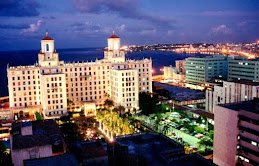
+azul.jpg)







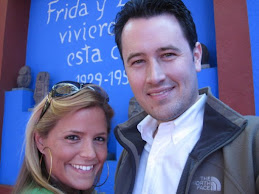.jpg)
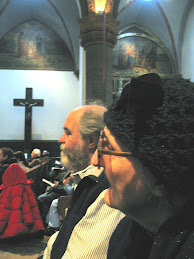

















.jpg)



.jpg)

.jpg)












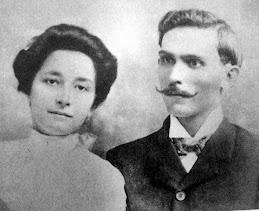

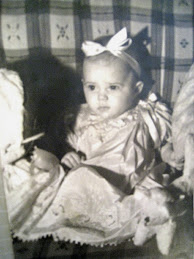
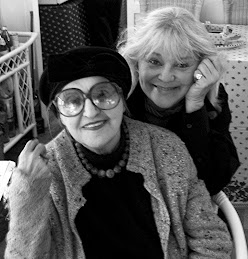
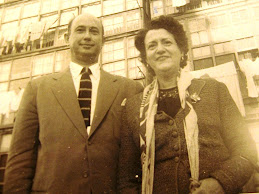

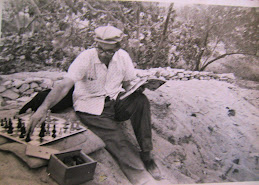
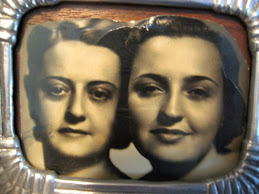
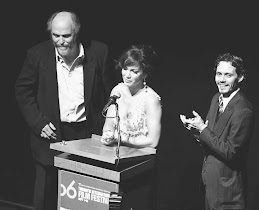
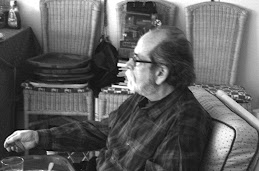
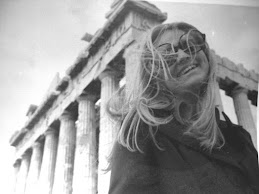

.jpg)

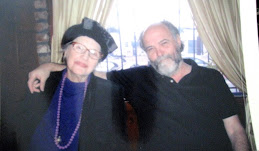
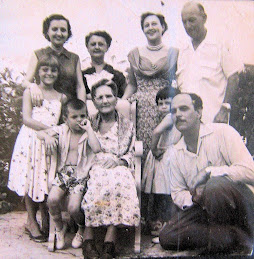
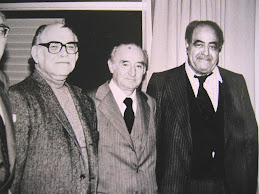


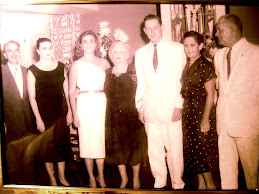


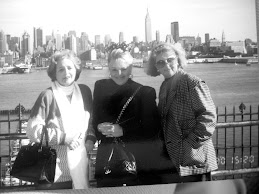

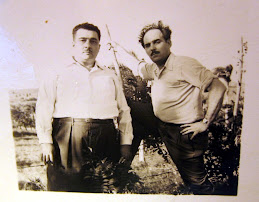

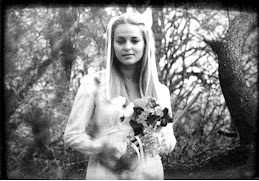
.jpg)
